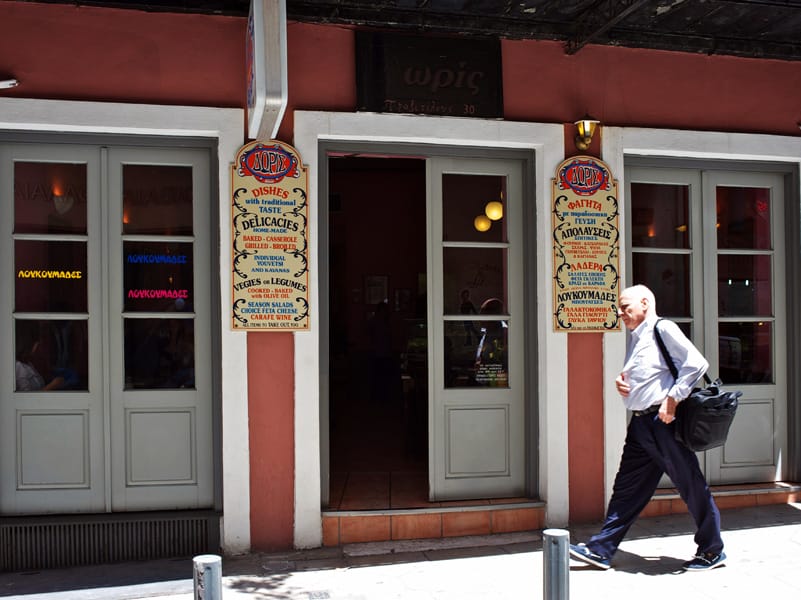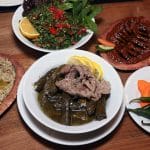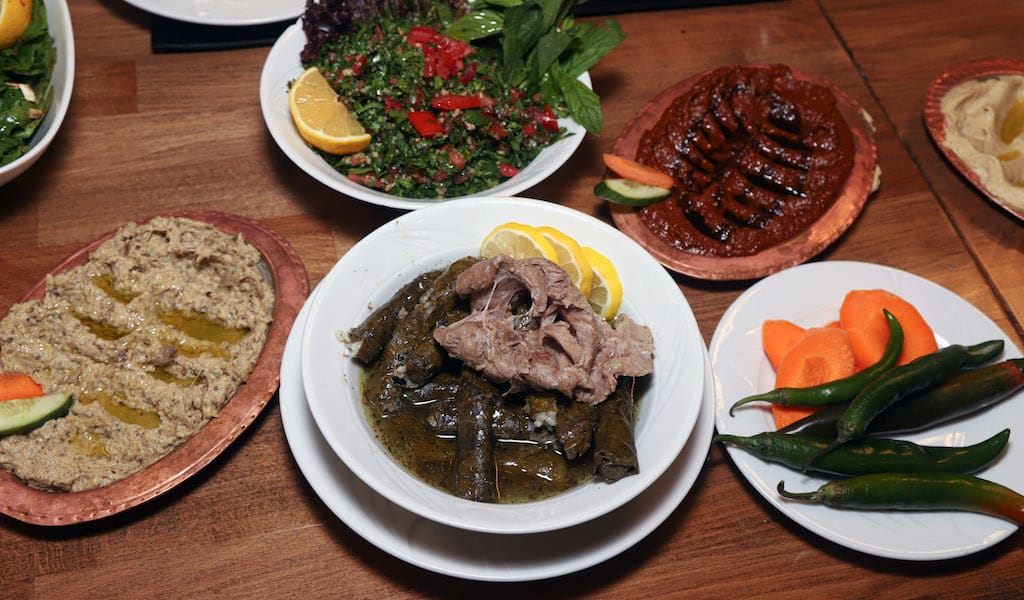Editor’s note, July 2013: Sadly, this classic Athens dining establishment recently closed down, a victim of the Greek financial crisis. Our Athens correspondent bids a fond farewell to Doris here.
Housed in a bright pink neoclassical-style building on bustling Praxitelous Street (a road full of shops selling electrical equipment, wholesale beads and jewelry supplies), Doris has been around since 1900. It’s a traditional Athenian eatery known as a mageireio, which roughly means “cooking house” or “eating place.”
Doris respects its past: the first thing you see when you walk in is a huge, old-fashioned glass counter, where food is displayed inside large pots and pans, allowing customers to see what’s cooking that day. The clientele – well-dressed yet demanding pensioners who are prone to shouting if their order doesn’t arrive exactly the way they want it, workers from the nearby area – all sit at Doris’s marble-topped tables and eat breakfast or lunch (the venue closes at 6:30 p.m.). Customer turnaround is quick, partially because of the friendly and fast service by the staff, a bunch of real characters who have worked here for years. Watching over the show is the always immaculately dressed manager, Thanos Kavatzas, who is constantly serving, supervising and making sure that all goes to plan.
Like most mageireia, Doris offers mageirefta, food that has been cooked, stewed or prepared the same morning, such as moussaka or stuffed tomatoes. Think along the lines of a warm buffet where you can pick and choose depending on what’s on offer. Doris’s strength lies in its homey, traditional Greek cuisine; it’s a wonderful place to eat vegetables and legume-based dishes.
Yet the restaurant’s offerings are greatly varied, ranging from meatballs to stewed fish. You may even see locals eating spaghetti Bolognese here, but be warned that Greeks have a tendency to overcook their pasta and Doris is no exception. The menu changes depending on the season but an all-around favorite starter is the grilled green peppers stuffed with cheese. The clean, simple flavors leave a pleasant aftertaste that prepares the palate for the hearty dishes to follow.
Our personal favorites here are the ladera, a whole category of Greek cuisine comprised of vegetables that have been stewed or cooked in olive oil. There is a heavy Turkish influence in most of these dishes, such as imam baildi (eggplant stuffed with tomato, garlic and onion), which is a big hit at Doris. Another traditional Greek favorite here is papoutsakia (the name means “little shoes”), a dish consisting of eggplants stuffed with ground beef and tomato and then topped with béchamel. Imagine a taste similar to moussaka: rich, meaty and lovely at the same time, it sits rather heavily on the stomach. Wintertime specialties at Doris include spanakorizo (spinach risotto) or laxanorizo (cabbage risotto); served warm, they go well with a generous sprinkling of lemon juice.
But the absolute must-try item at Doris – the thing that keeps so many people coming back here – is their loukoumades, fresh doughnut holes with honey and cinnamon. These honey-rich pastries are deep-fried in a large pan, then served piping hot with extra honey and cinnamon on top. Despite their almost dizzyingly sweet taste, you will end up dousing each doughnut in honey and cinnamon over and over again. Don’t be surprised if you need a nap and some time to recuperate afterwards.
Doris is not a grand venue but it’s clear that the people working here really care about what they are doing. Little touches like the small potted plants of blooming flowers on the tables and the daily menu written on a chalkboard in fancy lettering – and, most importantly, the simple, honest cooking – show how much love goes into the running of Doris every day. It’s all in the details, after all.
Published on August 20, 2012
Related stories
February 4, 2015
BarcelonaIt’s one of those culinary mysteries worthy of a good detective: namely, how did a drink the color of Pepto-Bismol become one of Barcelona’s most iconic libations? The story begins around 1975, when the bar La Barretina – then a hot spot, now long gone – began serving leche de pantera (“Panther Milk”). This milk-and-liquor…
November 14, 2021
Elsewhere | By Culinary Backstreets
ElsewhereWhether it’s Hacı Beşir Usta’s çiğ köfte from Istanbul’s Kadınlar Pazarı, a perfectly steamed Oaxacan tamale by Tia Tila or the Pang family’s late-night dumplings in Shanghai, street food and the folks who make it are the heart and soul of Culinary Backstreets. Yes, we love street food. It’s tasty. It’s fast. It’s cheap. But…
September 18, 2019
Istanbul | By Dima Al Sayed
IstanbulKhan al-Wazir is a remnant of Aleppo’s Ottoman past: In the late 17th century, the Ottoman governor of Aleppo commissioned the construction of this large caravanserai (in fact, its name means “caravanserai of the minister”), a building that housed both merchants and travelers. In 21st-century Istanbul, the former capital of the Ottoman Empire, a new Khan…

















































































